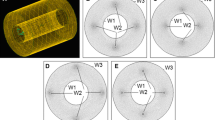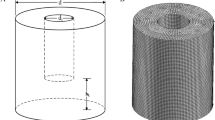Abstract
The hollow fiber membrane bioreactor (HFMB) has been investigated for the cultivation of mammalian Chinese hamster ovary cell expansion. The experiments were carried out in Petri’s dishes and in the hollow fiber membrane bioreactor having 20 fibers (S2025 from FiberCell Systems). The approach to HFMB modelling which combines the model of cell growth kinetics and hydrodynamics has been proposed. The hydrodynamic model is made using ANSYS Fluent software. The mathematical model of HFMB was developed, allowing the study of the hydrodynamics into the lumen and the extracapillary spaces, the filtration through the membrane fiber with the cell expansion on outer membrane surface. The direct nutrient medium flow variant into the extracapillary space was suggested. Based on the numerical simulations, the optimal parameters were selected for daily changes in the medium flow-rate into the lumen space. The HFMB scaling up was performed for the larger size HFMB (60 fibers).

















Similar content being viewed by others
Abbreviations
- G :
-
Acceleration of gravity, m/s2
- I :
-
Mass flow depending on cell consumption of nutrient medium and metabolites flow per one cell, kg/m s
- J :
-
Mass flow passed through membrane, kg/m s2
- K :
-
Population capacity (parameter for the limitation of the number of cells in population)
- L :
-
Membrane thickness, m
- n :
-
Number of pores on membrane surface, 1/m2
- N :
-
Count of cells at timepoint t, cell
- P :
-
Pressure, Pa
- Q :
-
Medium flow-rate into the lumen space in mode 3
- q c :
-
Consumption of nutrient medium for one cell, m3/s
- q met :
-
Consumption of metabolites released by one cell, m3/s
- r por :
-
Pore radius, m
- S :
-
Membrane surface area, m2
- t :
-
Time, s
- v :
-
Medium velocity along the axes, m/s
- α :
-
Membrane permeability coefficient, m2
- δ :
-
Relative calculation error, %
- μ :
-
Dynamic viscosity, Pa s
- µ cell :
-
Cell-specific growth rate, days−1
- ρ :
-
Medium density, kg/m3
- φ :
-
Pore tortuosity
- 1:
-
Lumen space
- 2:
-
Extracapillar space
- cal:
-
Data from calculation results
- exp:
-
Data from experiment
- in:
-
Input
- m:
-
Membrane
- out:
-
Output
- x, y, z :
-
Coordinates on axes, m
- w:
-
Wall
References
Lai T, Yang Y, Ng SK (2013) Advances in mammalian cell line development technologies for recombinant protein production. Pharmaceuticals 6:579–603
Milián E, Kamen AA (2015) Current and emerging cell culture manufacturing technologies for influenza vaccines. Biomed Res Int 2015:504831. https://doi.org/10.1155/2015/504831
Hambor JE (2012) Bioreactor design and bioprocess controls for industrialized cell processing. Bioengineering strategies and platform technologies. Bioprocess Internat 10(6):22–33
Eibl D, Eibl R, Portner R (2014) Cell and tissue reaction engineering: principles and practice. Springer, Berlin, p 363
Chapmana LAC, Whiteley JP, Byrne HM, Waters SL, Shipley RJ (2017) Mathematical modelling of cell layer growth in a hollow fibre bioreactor. J Theor Biol 418:35–56
Knazek R, Gullino P, Kohler P, Dedrick R (1972) Cell culture on artificial capillaries: an approach to tissue growth in vitro. Science 178:65–67
Sullivan JP, Gordon JE, Bou-Akl T, Matthew HWT, Palmer AF (2007) Enhanced oxygen delivery to primary hepatocytes within a hollow fiber bioreactor facilitated via hemoglobin-based oxygen carriers. Artif Cells Blood Substit Immobil Biotechnol 35(6):585–606
Khakpour S, Di Renzo A, Curcio E, Di Maio FP, Giorno L, De Bartolo L (2017) Oxygen transport in hollow fibre membrane bioreactors for hepatic 3D cell culture: a parametric study. J Membr Sci 544:312–322
Abdullah NS, Jones DR, Das DB (2009) Nutrient transport in bioreactors for bone tissue growth: why do hollow fibre membrane bioreactors work? Chem Eng Sci 64(1):109–125
Mohebbi-Kalhori D, Behzadmehr A, Doillon CJ, Hadjizadeh A (2012) Computational modeling of adherent cell growth in a hollow fiber membrane bioreactor for large-scale 3-D bone tissue engineering. J Artif Organs 15(3):250–265
Roberts I, Baila S, Rice RB (2012) Scale-up of human embryonic stem cell culture using a hollow fibre bioreactor. Biotechnol Lett 34(12):2307–2315
Eghbali H, Nava MM, Mohebbi-Kalhori D, Raimondi MT (2016) Hollow fiber bioreactor technology for tissue engineering applications. Int J Artif Organs 39(1):1–15
Wung N, Acott SM, Tosh D, Ellis MJ (2014) Hollow fibre membrane bioreactors for tissue engineering applications. Biotechnol Lett 36(2):2357–2366
Nold P, Brendel C, Neubauer A, Bein G, Hackstein H (2013) Good manufacturing practice-compliant animal-free expansion of human bone marrow derived mesenchymal stroma cells in a closed hollow-fiber-based bioreactor. Biochem Biophys Res Commun 430:230–325
Storm MP, Sorrell I, Shipley R, Regan S, Luetchford KA, Sathish J, Webb S, Ellis MJ (2016) Hollow fiber bioreactors for in vivo-like mammalian tissue culture. J Vis Exp 111:53431
Sharma C (2013) Review of computational fluid dynamics applications in biotechnology process. Biotechnol Programs 27:1497–1510
Zhang H, Wang W, Quan C, Fan S (2010) Engineering considerations for process development in mammalian cell cultivation. Curr Pharm Biotechnol 11:103–112
Weyand B, Israelowitz M, von Schroeder HP, Vogt PM (2009) Fluid dynamics in bioreactor design: considerations for the theoretical and practical approach. Adv Biochem Eng Biotechnol 112:251–268
Guyot YA (2015) Three-dimensional computational fluid dynamics model of shear stress distribution during neotissue growth in a perfusion bioreactor. Biotechnol Bioeng 112:2591–2600
Pok S, Dhane DV, Madihally SV (2013) Computational simulation modelling of bioreactor configurations for regenerating human bladder. Comput Methods Biomech Biomed Eng 16(8):840–851
Schausberger P (2009) Simulation of protein ultrafiltration using CFD: comparison of concentration polarisation and fouling effects with filtration and protein adsorption experiments. J Membr Sci 337:1–8
Madaenius SS (2010) Investigation of cake deposition on various parts of the surface of microfiltration membrane due to fouling. Korean J Chem Eng 27(1):206–213
Liu Y, He G, Ding L, Dou H, Ju J, Li B (2012) Experimental and CFD studies on the performance of microfiltration enhanced by a turbulence promoter. Chin J Chem Eng 20(4):617–624
Ladeg S, Zhu Z, Moulai-Mostefa N, Ding L, Jaffrin MY (2018) CFD simulation of the distribution of pressure and shear rate on the surface of rotating membrane equipped with vanes for the ultrafiltration of dairy effluent. Arabian J Sci Eng 43(5):2237–2245
Shipley RJ, Davidson AJ, Chan K, Chaudhuri JB, Waters SL, Ellis MJ (2011) A strategy to determine operating parameters in tissue engineering hollow fiber bioreactors. Biotechnol Bioeng 108(6):1450–1461
Chapman LAC, Shipley RJ, Whiteley JP, Ellis MJ, Byrne HM, Waters SL (2014) Optimising cell aggregate expansion in a perfused hollow fibre bioreactor via mathematical modelling. PLoS One 9(8):e105813
Song K, Yan X, Zhang Y, Song F, Lim M, Fang M, Shi F, Wang L, Liu T (2015) Numerical simulation of fluid flow and three-dimensional expansion of tissue engineering seed cells in large scale inside a novel rotating wall hollow fiber membrane bioreactor. Bioprocess Biosyst Eng 38:1527–1540
Pearson NC, Waters SL, Oliver JM, Shipley RJ (2015) Biomech Model Mechanobiol 14:387–402
Pilarek M, Grabowska I, Senderek I, Wojasiński M, Janicka J, Janczyk-Ilach K, Ciach T (2014) Liquid perfluorochemical-supported hybrid cell culture system for proliferation of chondrocytes on fibrous polylactide scaffolds. Bioprocess Biosyst Eng 37(9):1707–1715
Selvarasu S, Ho YS, Chong WPK, Wong NSC, Yusufi FNK, Lee YY, Yap MGS, Lee D-Y (2012) Combined in silico modeling and metabolomics analysis to characterize fed-batch CHO cell culture. Biotechnol Bioeng 109:1415–1429
Kafarov VV, Vinarov AYu, Gordeev LS (1987) Modelling of bioreactors. Int Chem Eng 27:615–641
Yahia BB, Malphettes L, Heinzle E (2015) Macroscopic modeling of mammalian cell growth and metabolism. Appl Microbiol Biotechnol 99:7009–7024
Singh H, Hutmacher DW (2009) Bioreactor studies and computational fluid dynamics. Adv Biochem Eng Biotechnol 112:231–249
Zwietering MH, Jongenburger I, Rombouts FM, Van Riet KT (1990) Appl Environ Biotechnol 1875–1881
Shao X, Lynd L, Bakker A, LaRoche R, Wyman C (2010) Reactor scale up for biological conversion of cellulosic biomass to ethanol. Bioprocess Biosyst Eng 33(4):485–493
Zou X, Xia J, Chu J, Zhuang Y, Zhang S (2012) Real-time fluid dynamics investigation and physiological response for erythromycin fermentation scale-up from 50 L to 132 m3 fermenter. Bioprocess Biosyst Eng 35:789–800
Kaneda Y, Kawamura H, Sasai M (2007) Numerical experimentation: a third way frontiers of computational sciences to study nature. Front Comput Sci 15–30
Acknowledgements
This research was supported by the Ministry of Science and Higher Education of the Russian Federation within the framework of Basic Component of the State Assignment (no 10.4658.2017/6.7).
Author information
Authors and Affiliations
Corresponding author
Ethics declarations
Conflict of interest
Natalya V. Menshutina, Elena V. Guseva, Ruslan R. Safarov and Joseph Boudrant declare that they have no conflict of interest.
Additional information
Publisher's Note
Springer Nature remains neutral with regard to jurisdictional claims in published maps and institutional affiliations.
Rights and permissions
About this article
Cite this article
Menshutina, N.V., Guseva, E.V., Safarov, R.R. et al. Modelling of hollow fiber membrane bioreactor for mammalian cell cultivation using computational hydrodynamics. Bioprocess Biosyst Eng 43, 549–567 (2020). https://doi.org/10.1007/s00449-019-02249-9
Received:
Accepted:
Published:
Issue Date:
DOI: https://doi.org/10.1007/s00449-019-02249-9




